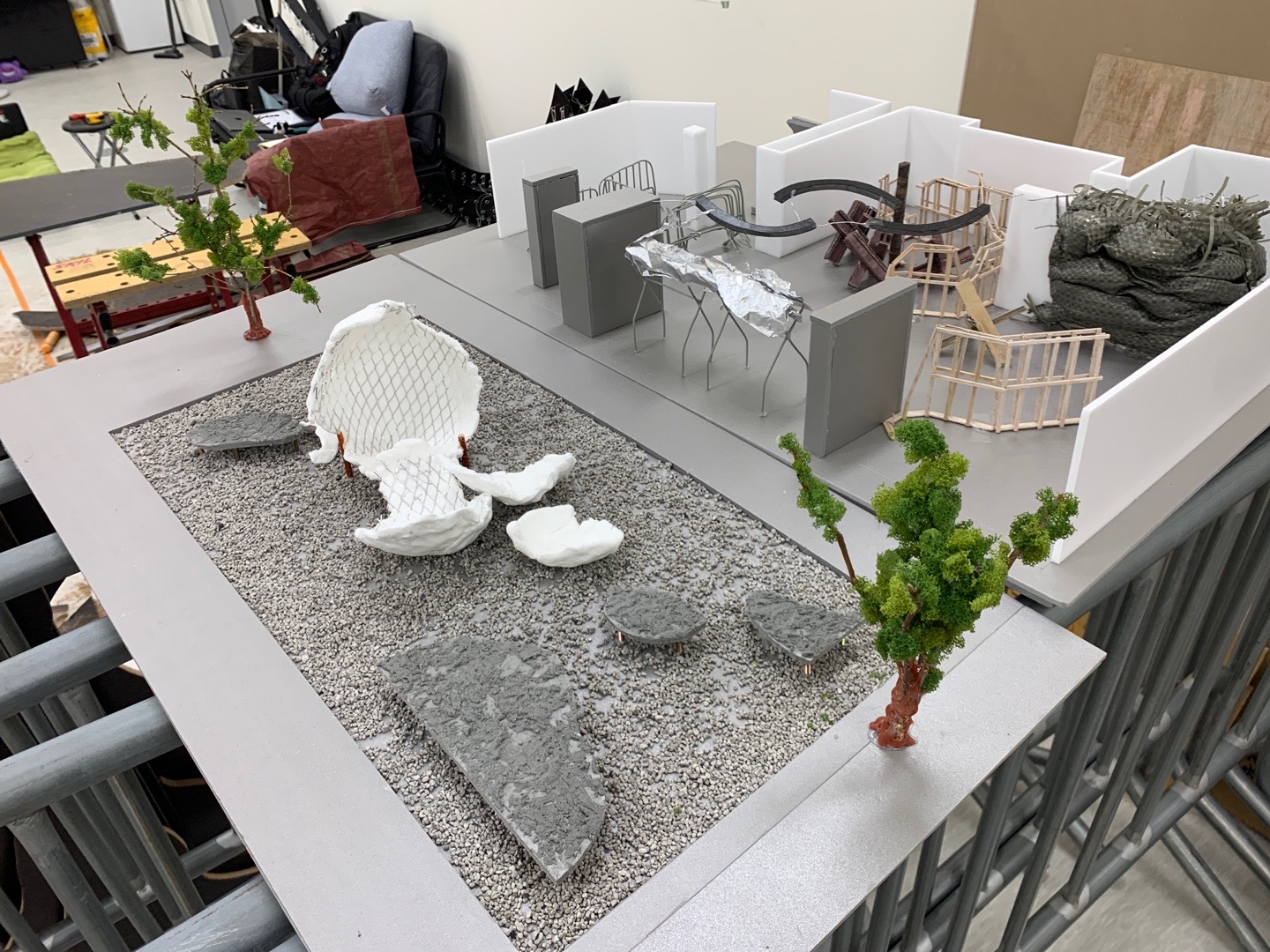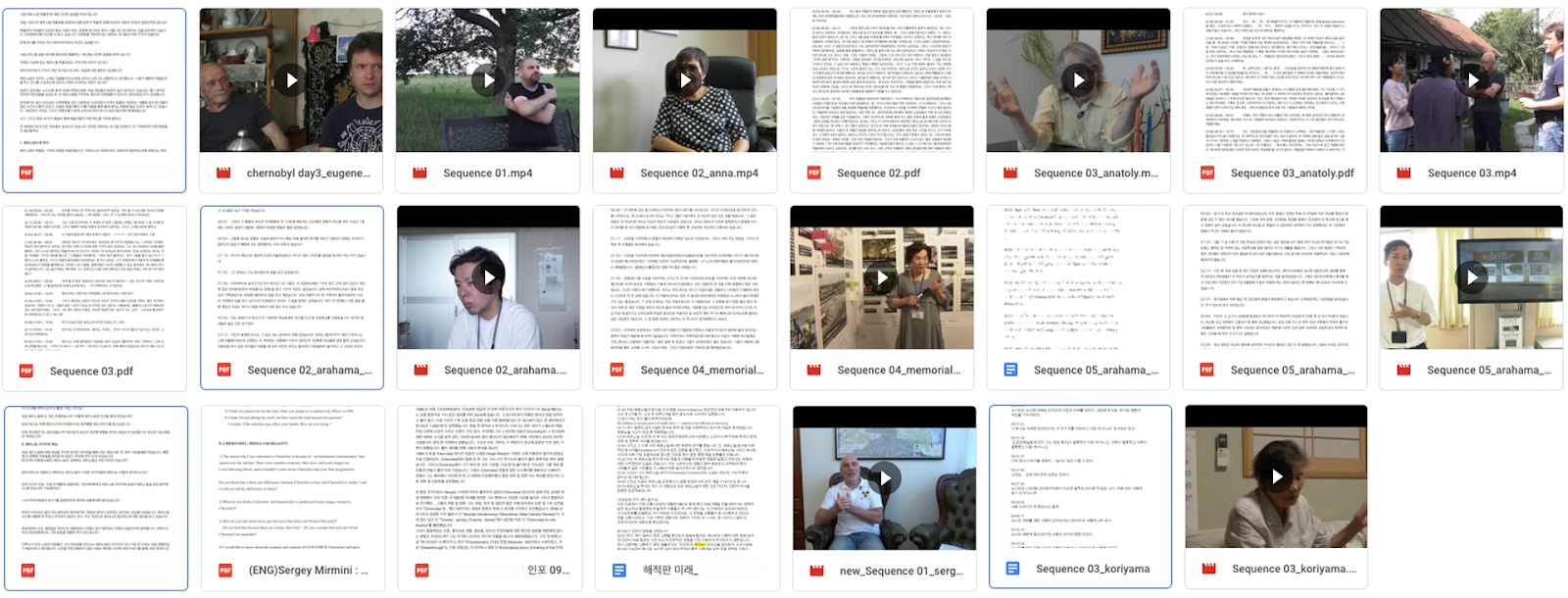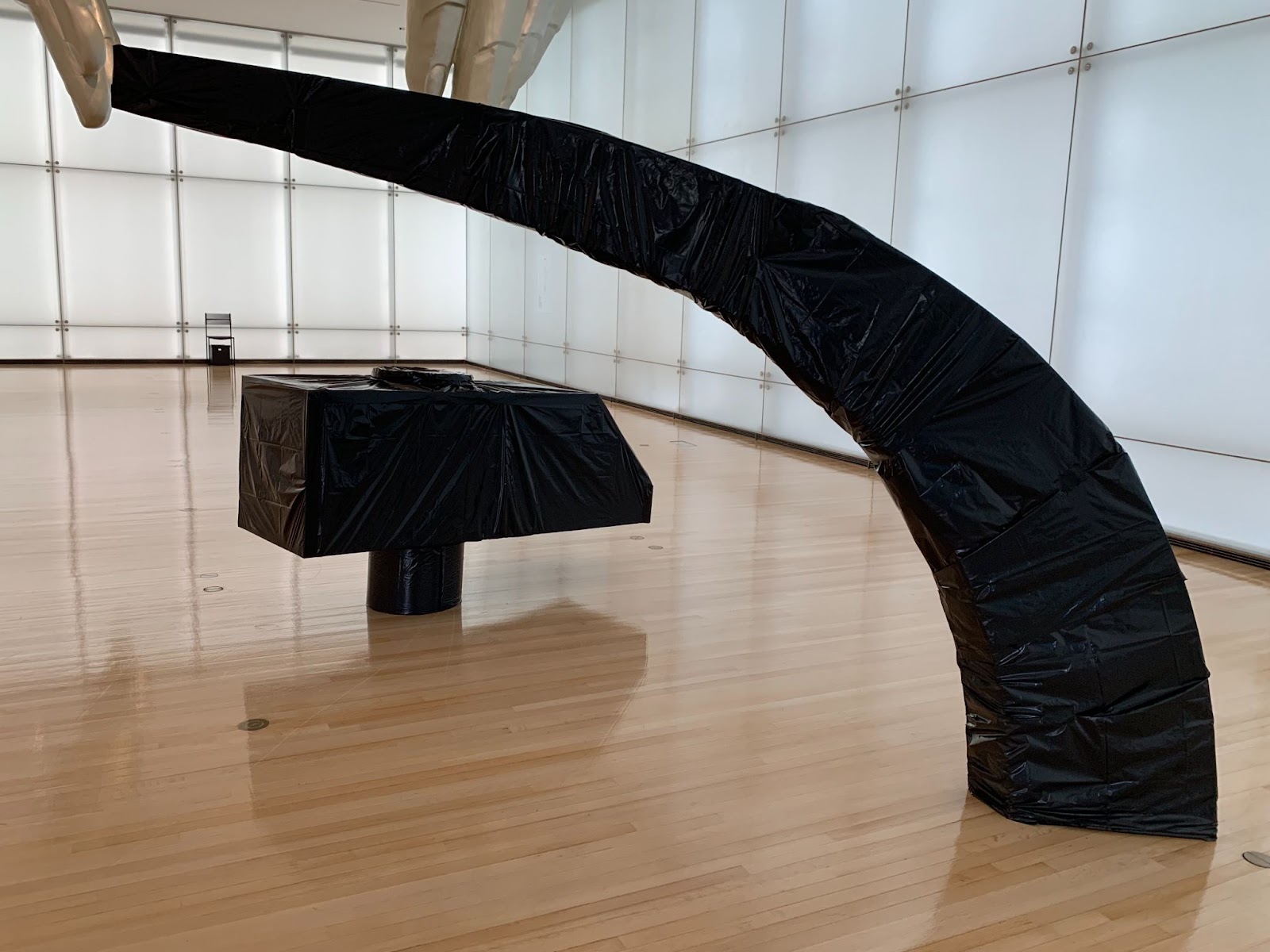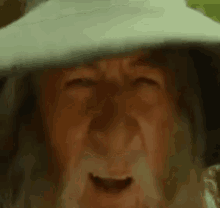Seewon Hyun
1.
Theater without movies, RUN
Eugene Jung’s solo exhibition RUN is almost like a ‘theater without movies’. It is a ‘table without MacBook 95’ and a ‘future without the psychic octopus.’ It is a ‘disaster without catastrophe’. Eugene Jung asks a question and then leaves, comes back and speaks another language. She drives a rattling car at night and walks through the streets of Seoul with her shoelaces untied as if she was escaping at night. Is she busy or distracted, or is she attending a ‘strange hagwon (Korean system)‘ that she created for herself?
The dissonance between subject and context, event and space-time (environment) is the driving force behind Jung’s work. Let’s start by looking at what’s in the exhibition space of RUN in the summer of 2022. The structure of RUN ‘edits’ escape, settlement, theme park, cafe, theater, and exhibition space. No single movie is screened here. This is an ‘edited space’ that assumes a ‘viewing subject’. The artist coordinates the exhibition space as a viewing environment and coordinates the spatial timeline of individual works. What is a ‘movie’ when it comes to a theater without movies? It (movie or MacBook) doesn’t matter if it’s not a documentary film, which is the medium Eugene Jung is currently focusing on. Also, it doesn’t matter whether it is an image composed of memes from a smartphone, a real estate YouTube lecture, or a restaurant tour.
As curator Hyukgue Kwon wrote, this exhibition space is the totality of “clumsy and temporary camouflage techniques”. As can be seen from the artist’s drawings and scaled-down models, the space and arrangement of the works are important. This arrangement shows a montage of Eugene Jung’s cartoonic plans and declarative titles. The words she deals with in the titles are mainly reversed, connecting things that are difficult to exist together. Like ‘Growing gravestone’ or ‘Mercilesspilar’. The relationship between space and individual works also needs to be highlighted at the formal level.

In RUN, individual works are placed by properly recognizing both inside and outside of the exhibition space. Plans and declarations coexist, and the installation of light materials clad in a cloak of cartoonish imagination and abstraction takes place. Let’s go to the front of museumhead. The artist’s pink flag hangs outside the building. The installation in the front yard was made like the one of the ‘stone museum’ on Jeju Island or of folk museums in other countries. Thick paper and thin plywood, a taste for traces that seem to have endured a long time, and the sense of volatilization armed with instant spirit coexist. Her works occupy the front of the exhibition space. Let’s go to the back of the space. Although it is called camouflage, it seems to be able to avoid the recent downpour to some extent, and it even looks safe. That is Dead end(2022), where the sandbags shipped from overseas are piled up. This work is a heavy background screen in itself, things that are too bulky to serve as background screens. However, they are basic infrastructures such as highways and internet networks. The sandbag is the actual reality of 2022 with wars taking place, and is the backdrop for the loss of the ‘specific information value’. As for the stage direction, it reminds me of the birds that appeared in the 2018 Pyeongchang Biennale, which was ‘too much excess’. So, the questions that come to mind are ‘Where am I?’ ‘What is my distance from disaster?’ and so on. Overall, something too heavy for a background. In an era where incongruity and inhomogeneity have become the aesthetics of packaging, rather than hiding them behind, Eugene Jung‘s making process calls for too much sweat and physical labor.
There is a second reason why I say Eugene Jung’s RUN is like a theater without movies. It is because of the connection with the artist’s past work. In fact, she has dealt with video work and theater as her work materials. In particular, how she created a ‘theater’ as a screening environment is important for me. Let’s recall her exhibition Pirated Future + Doomsday Garden(2019, Art Sonje Center Art Hall) held at Art Sonje Center Art Hall in 2019. I remember the exhibition space full of green trees that looked like unmanageable loose hair. During the 48 minutes when the movie Pirated Future was screened, the movie was not a ‘single-channel video.’ There was ‘unseen space’ created by Eugene Jung, so much that I was confused about the sound of firecrackers coming out of the movie and whether the smartphone screen was shaken when I was taking a photo or if a small earthquake occurred at the time. The audience could walk and wander through the installed works. In the strict presence of the theater audience seats, her sign ‘+’ is an important clue.
There is no exclamation mark in the title of this exhibition. However, after seeing the exhibition, I seem to have thought of the flag as an exclamation point (!) in my head. Or was it a question mark? Eugene Jung’s results of moving around in the midsummer sweat and searching for areas with contemporary issues look like art and at the same time, an exploration report. They are the remnants of reality surrounding the outer skin pretending to be art. What should I believe? Just as + was not simply adding the installation Doomsday Garden and the movie Pirated Future, where and how does Eugene Jung’s ‘Run’ call the audience? Eugene Jung’s fearless installation, which penetrated the audience seats of the Art Sonje Center Art Hall theater, distractedly interrupted the movie viewing and disturbed the audience’s vision. It is similar to I•SMILE•U(2022), which was on the ceiling of the exhibition space this summer. The gaze towards the ceiling is reflected by the glass window of museumhead. In RUN, Eugene Jung seems to have coordinated the movement of space with the sense of making a movie. In other words, for Eugene Jung, movie and theater cross and penetrate each other. In 2019, Eugene Jung’s theater was not a space where you can fully focus on the movie. As such, the exhibition space museumhead becomes a space-time that materializes the escape itself, not a place to find a ‘fixed place’ for individual works.
2.
Eugene Jung MacBook 95, Individual and Society
Eugene Jung often uses humor to otherize herself. She arranges the materials in a distracting manner and rolls them up, then comes to the exhibition space and unfolds them larger. She puts something on the floor and lets the audience sit on it. In Funeral of Eugene95’s MacBook Pro, Eugene Jung put her birth year at the end of the computer username she was using. Local specialties and industrial products are labeled with the year of production, but in everyday life, the birth year is not usually attached to a person. As with anyone, being online, keeping records, everyday life, information, distribution, and economy are all in the MacBook (laptop) and mobile phone. When you’re thinking, training, and replying with a laptop and it doesn’t turn on, it’s a ‘disaster.’ The MacBook used by the artist was(is) her exhibition space, theater, theme park, bank, and artificial life itself in which the future and the past are alive. One day when all the files on the MacBook were destroyed, the artist made a work to commemorate the death of the MacBook. The work placed in the exhibition space within the space-time of “seated movement flow” was a chair that doubled as a table, a coffin for objects, and a temporary passage for people. The chair made by Eugene Jung was also a seat for viewing the video work of another artist Taiyo Kobayashi in the two-person exhibition.
The death of the MacBook is a story. What is as important as the media in Eugene Jung’s work is the impulse to make a story. Critics Wonhwa Yoon and Yuki Konno also discussed the importance of the story in their writings. Until now, it has been often said that Eugene Jung is discussing the subject of ‘disaster’ and catastrophe. The existence of a reality that she brings as a starting point and a clue to her work has been often derived from parts of a story. Psychic octopus, space-time and the subjects of disaster, and the moment her long-used MacBook broke down all became a work. The motif of the psychic octopus became Resurrection of Paul the Psychic Octopus(2019), and MacBook’s disaster was reborn as a white table and pseudo-coffin in Drift Bottle at Audio Visual Pavilion in 2021. What story is she interested in? What materiality does it combine with? What is clear is that it is not enough for her to be ‘interested’ in disasters, and the focus of the discussion should shift to the fact that her works suggest the perspective of a female artist born in 1995 looking at society.
In early 2021, I asked 10 questions to the two artists of Drift Bottle, Eugene Jung and Taiyo Kobayashi. I asked the artist who used ‘eugeene95’ to answer the questions with visual images. Let’s bring some of the questions and answers from them.
First, as artists, have you ever had a conversation about the year you were born?
If so, what was it?
Second, do you think catastrophe can have a commonality? Or is the individuality of the catastrophe felt by the individuals more important?
Third, in the case of Eugene Jung, she once made her ‘laptop image’ into a ‘desktop image’. It’s like putting a desktop image on the desktop. Are you always quick to do things you want to do?
Then, to the first question, Eugene Jung answered that the day she was born, March 20, 1995, was the day of the Tokyo Subway Sarin Attack. The source is Wikipedia. “March 20, 1995 – Aum Shinrikyo believers spray sarin gas in the Tokyo subway. (Tokyo Subway Sarin Attack)
The second question about the individuality and commonality of catastrophe or disaster was answered by showing the following image with a caption. From around 2017 when Eugene Jung started her practice until 2022, disasters and catastrophes have been ‘renewed’ every moment ranging from the earthquake in Japan, a political catastrophe to the Covid-19 in 2020. Eugene Jung responded as if emphasizing individuality by showing the interview scripts she used while making Pirated Future.

Video work Pirated Future Interview Script

When I first set up my desktop (June 2020)
Lastly, to the question of creating a desktop image with a computer desktop image, she answered with this image.
3.
Black wrapping paper and ‘Situation’
Finally, let’s discuss the fact that artist Eugene Jung pays attention to real-world disasters, mass media, and personal social media. Artist Eugene Jung posted photos like these when she was a viewer in 2019. She visited the Aichi Triennale 2019 (2019.8.1.-10.14) held in Nagoya and posted a photo of a huge statue carefully wrapped with black plastic on her Instagram. (@newgenejung) The frames of the works were covered with newspapers. It seemed to be done with care. The original state of the works remain on the Aichi Triennale website. (https://aichitriennale.jp/en/artwork/T10.html)


At the Aichi Triennale 2019, some participating artists restricted viewing of their works, resisting the suspension of the exhibition Unfreedom of Expression which included a Statue of Peace (also known as Comfort Woman Statue). According to Eugene Jung who had seen the exhibition, the works were not just removed, voluntarily taken out of the exhibition space, or just turned off as a form of resistance. Cuban artist Reynier Leyva NOVO said, “The exhibition continued with sculptures completely covered in black plastic and paintings covered with newspapers about government censorship.” Eugene Jung arrived in Nagoya on a late-night bus, saying, “I’m going to go see how they restricted the viewing.” She went to see how they didn’t let people see. “The viewers can choose to be the audience of the Aichi Triennale or the audience of the Aichi Triennale ‘Situation’.”
Can exhibition-making be a situation? At the Triennale she went to see on a late-night bus, she went not to see something, but to check what she couldn’t see. While going to see RUN, the audience must have experienced a lot of hot weather and rain. RUN is a solo exhibition of Eugene Jung held in the summer of 2022. Her exhibitions have been held during very cold or hot times. Although not always the case, during this exhibition, Seoul experienced its first downpour in 100 years, so this exaggeration would be acceptable. The relationship between contemporary art exhibitions and climate is urgent, and climate seems to be an opportunity to break through the conditions of exhibition-making for Eugene Jung. Weather, as a subject of perception of reality, is a social issue and daily life that replaces the political and socio-cultural issues of the 1980s. In 2018, the work in the Audio Visual Pavilion exhibition space located at 57-6 Jahamun-ro revealed the burning black debris in the hot summer. The day I visited the Art Sonje Center in 2019 was also cold. The weather outside of the Drift Bottle exhibition held at the Audio Visual Pavilion Lab in 2021 was below the freezing point and the Covid-19 was in full swing.
Whether it is a disaster or the weather outside, Eugene Jung spreads, cuts, and attaches materials until she arrives at the exhibition space. It leads to creating an environment for showing, putting an exclamation mark, and finding commonalities and fragmentation between individuals and societies experiencing stories. Her medium ranges from sculpture, installation, and drawing to cartoon. A common feature among these many media and materials that she deals with is the ‘spirit of humor’. Eugene Jung, who materializes this humor, drives a car and jumps directly into the road. It is unknown whether it will be a fiery reality or a space-time full of lies and ruins, but she sets off anyway.
Let’s look back at this exhibition where we started. Eugene Jung installed works in front of the building and on the ceiling inside the exhibition space. In her work, humor and remnants of events coexist with heavy masses and shells of sculptures required for installation. Although her work is still in its infancy (young age), it is a visual language with multiple layers.
1. ‘Hagwon’ is an expression used by the novelist Min Jin Lee.
2. Hyukgue Kwon, You Better Run! , museumhead, 2022
3. Pirated Future + Doomsday Garden was exhibited at Art Sonje Center Art Hall from December 12 to 15, 2019. During the four-day period, the total screening of the movie was 8 times, twice a day at 4 and 6pm.
4. http://eugenejung.com/texts/온전히-가닿지-않을지라도/, Yijoo Park, Even if it cannot fully reach you, Korea National University of Arts Magazine #37
5. ‘Black wrapping paper’ part is a modified version of ‘Audience Numbering’ included in Quarterly Audio Visual Pavilion #3(2019).
6. Interview with Eugene Jung, 2019. 9.9.
7. The first downpour in 100 years fell for two weeks in August 2022, when the exhibition was held.


